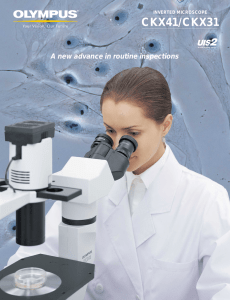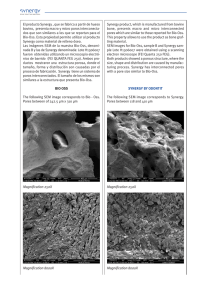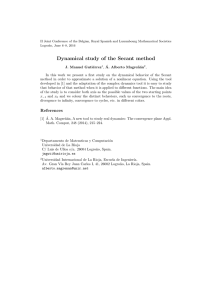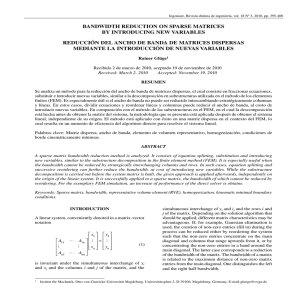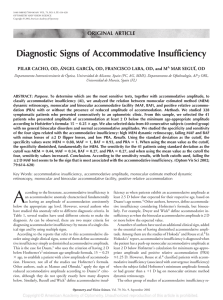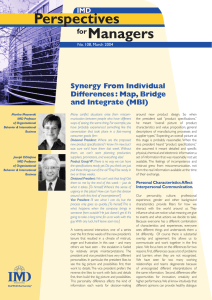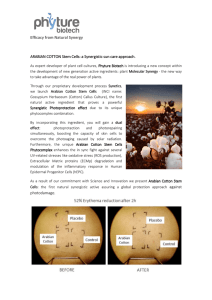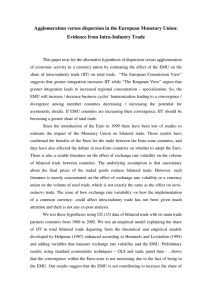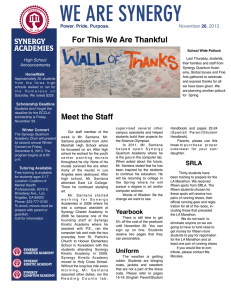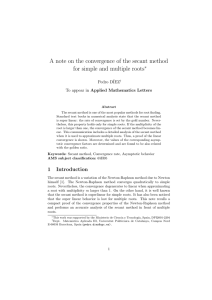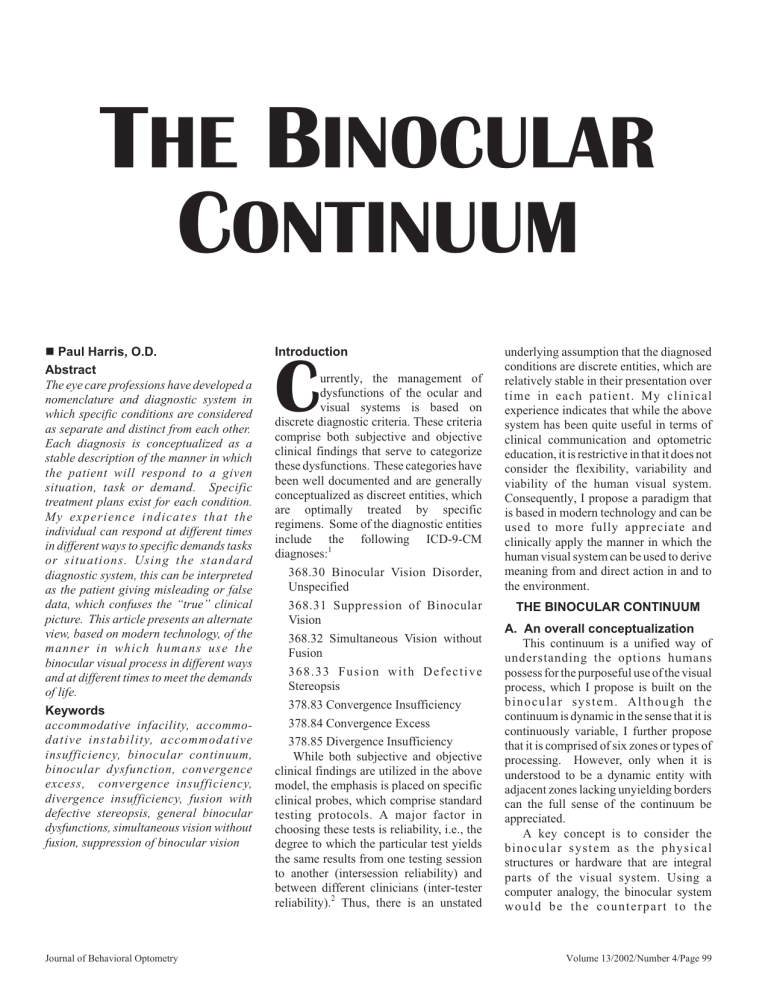
THE BINOCULAR CONTINUUM n Paul Harris, O.D. Abstract The eye care professions have developed a nomenclature and diagnostic system in which specific conditions are considered as separate and distinct from each other. Each diagnosis is conceptualized as a stable description of the manner in which the patient will respond to a given situation, task or demand. Specific treatment plans exist for each condition. My experience indicates that the individual can respond at different times in different ways to specific demands tasks or situations. Using the standard diagnostic system, this can be interpreted as the patient giving misleading or false data, which confuses the “true” clinical picture. This article presents an alternate view, based on modern technology, of the manner in which humans use the binocular visual process in different ways and at different times to meet the demands of life. Keywords accommodative infacility, accommodative instability, accommodative insufficiency, binocular continuum, binocular dysfunction, convergence excess, convergence insufficiency, divergence insufficiency, fusion with defective stereopsis, general binocular dysfunctions, simultaneous vision without fusion, suppression of binocular vision Journal of Behavioral Optometry C Introduction urrently, the management of dysfunctions of the ocular and visual systems is based on discrete diagnostic criteria. These criteria comprise both subjective and objective clinical findings that serve to categorize these dysfunctions. These categories have been well documented and are generally conceptualized as discreet entities, which are optimally treated by specific regimens. Some of the diagnostic entities include the following ICD-9-CM diagnoses:1 · 368.30 Binocular Vision Disorder, Unspecified · 368.31 Suppression of Binocular Vision · 368.32 Simultaneous Vision without Fusion · 368.3 3 Fus i on w i t h D ef ect i ve Stereopsis · 378.83 Convergence Insufficiency · 378.84 Convergence Excess · 378.85 Divergence Insufficiency While both subjective and objective clinical findings are utilized in the above model, the emphasis is placed on specific clinical probes, which comprise standard testing protocols. A major factor in choosing these tests is reliability, i.e., the degree to which the particular test yields the same results from one testing session to another (intersession reliability) and between different clinicians (inter-tester reliability).2 Thus, there is an unstated underlying assumption that the diagnosed conditions are discrete entities, which are relatively stable in their presentation over time in each patient. My clinical experience indicates that while the above system has been quite useful in terms of clinical communication and optometric education, it is restrictive in that it does not consider the flexibility, variability and viability of the human visual system. Consequently, I propose a paradigm that is based in modern technology and can be used to more fully appreciate and clinically apply the manner in which the human visual system can be used to derive meaning from and direct action in and to the environment. THE BINOCULAR CONTINUUM A. An overall conceptualization This continuum is a unified way of understanding the options humans possess for the purposeful use of the visual process, which I propose is built on the bi nocul ar s ys t em . A l t h o u g h t h e continuum is dynamic in the sense that it is continuously variable, I further propose that it is comprised of six zones or types of processing. However, only when it is understood to be a dynamic entity with adjacent zones lacking unyielding borders can the full sense of the continuum be appreciated. A key concept is to consider the binocular system as the physical structures or hardware that are integral parts of the visual system. Using a computer analogy, the binocular system w oul d be t he count er p a r t t o t h e Volume 13/2002/Number 4/Page 99 computer’s basic operating system. Software in this analogy would be the stored sets of instructions that constitute the patterns of use of the hardware. This sets up the possibility that one can have different programs or different patterns of use of the hardware that can be used at different times and/or under different internal or external conditions. In terms of binocular vision testing, the clinician observes the patient’s response at one point in time and makes the judgment that the system is used in a particular way. This results in a particular diagnosis. However, if the patient’s attitude, state of health or fatigue, or level of attention is not precisely the same at another point in time, there can be a very different test response and a different diagnostic label will be attached. If one understands this type of variability of response, binocularity can be considered the range of patterns of use of the system in response to varying conditions and demands. In essence, the available hardware or software is not being used in the same manner in the two instances. This provides the person with options that allow him various behavioral and perceptual outcomes depending upon which patterns of organization are used to meet the demands placed before them. A somewhat analogous situation occurs in a massively complex and parallel sound system capable of recreating threedimensional effects to a listener positioned at its apex. Different software is available to allow the shaping of the sound to simulate different types of listening environments. Things such as reverberation, delay times between speakers, variable equalizer settings, can be changed which alter the sound being generated resulting in a wide range of potentially different perceptions by the listener. In a similar manner the binocular visual system is viewed as a highly complex massively parallel process endowed with a multitude of potential modulations and alterations that can be made as needed to meet the demands of the situation at hand. Some of the specific methods to attain these modulations and alterations are: · Bandwidth adjustments: Bandwidth refers to the amount of data that is transferred simultaneously through the Volume 13/2002/Number 4/Page 100 · system. A wider bandwidth occurs when a great deal of information is m ovi ng t hr ough t he s ys t em , simultaneously providing the person with more data upon which to make a decision. A narrow bandwidth occurs when only a portion of the capability of the system is in use at one time. In this condition less data is available for the person’s decision making. If the person stays in this condition for too long she will make inaccurate decisions. The bandwidth in use at any moment is not a fixed characteristic of the hardware. Rather, the bandwidth in use is under software control and is adjusted to meet the demands of the task. Certain tasks are best handled with a wide bandwidth and others with a narrower, more concentrated bandwidth. For example, in one instance the person might be involved in removing a splinter from his finger; here a concentration of visual attention to a small volume of space is optimal. In another instance the person might be taking evasive action in directing a car around an accident in progress; here attention to a wide area of space is optimal. Visual data from an enormous volume of space may be necessary to successfully avoid becoming a part of the accident. Direction of flow: This refers to how information or data moves along through the myriad of possible connections that are part of the eye-brain complex as the person uses the data in a meaningful way. The optic nerve used to be thought to serve exclusively as an afferent nerve bringing information from the eyes into the lateral geniculate and then on to the primary visual cortex (V1). In recent years more and more branches of the optic nerve have been discovered and even the purely afferent role of the optic nerve has been brought into question.3 For purposes here the specific branches do not need to be elucidated. In a very simplified view we can talk about the primary flow to V1 feeding two sub-flows that have been labeled the dorsal, “what-is-it,” stream and the ventral, “where is it,” stream.4,5 Information about “what” and “where” is coordinated by linkages directly between the dorsal and ventral streams further along the pathways. To solve different problems presented in the real world may require different degrees of “computing” to be done by different sections of the brain. As an analogy one can think of a flow of a liquid through a system of pipes with multiple branches controlled by a series of valves and shunts. The flows through these valves are rarely if ever zero and rarely if ever reach full capacity. The total flow is directed to the parts of the brain as needed to deal with the moment-to-moment needs of the person. Some of the questions that get answered are: To which sections of the brain is information being shunted or diverted? Does the task the person is involved with require a snap judgment as to location in space, which would require a greater degree of the flow to be directed momentarily to the dorsal stream, or does it require a quick identification of friend of foe and thus require a shunting over to the ventral streams? f i l t eri n g / se l e c t i v e · Sel ect i ve amplification: Within these dorsal and ventral streams, portions of the flow can be filtered or be selected for amplification. This allows the person to finely adjust the signal-to-noise ratios within each flow; so that the m om ent - t o- m om en t u se o f t h e information is maximally efficient. When a person anticipates seeing a specific object or is used to a specific event occurring in a specific location in space, he is able to preset the filters and amplification system for the task. This sets the stage so that we recognize things we anticipate seeing more r eadi l y t han t hose wh i c h a r e unexpect ed. T hes e p r o c e sse s, controlled by attention and changing from moment-to-moment based on recalling prior events and anticipating coming events, are rarely the same, even in the same person. These are all examples of how individuals are able to modify and use visual information depending on the specific demands of the situation or task at hand. PET and f-MRI testing have shown massive and rapid blood flow and resource consumption changes as these people use their brain to perform different aspects of a task, different tasks, or even the same tasks during the learning versus the mature phase of performing such a task.5 Journal of Behavioral Optometry The Binocular Continuum Synergy Integration Interaction Interference Alternation Single Sided Figure 1. A graphic representation of the components or processing styles of the Binocular Continuum As people develop their visual abilities, they use the above methods of control to enhance the capabilities of the visual process. These methods are learned and enhanced as a part of the human developmental process. Not all people have the same developmental history and therefore different people will develop differing abilities to use these methods. Some individuals may find that they prefer certain ways to deal with certain demands. They may not have the conscious awareness of these preferences. In what ways can a person choose to use an intact binocular process? I propose that there are many ways that either do not reveal themselves on a regular basis and thus are not available for inspection, or are so fleeting in their expression that they have yet to be described. The six ways brought to light by this article probably do not constitute the whole universe of ways which the binocular process can be used. These six ways are proposed as being highly prevalent, clinically observable, and relevant for discussion. The first order of business here though is to define a few more terms. B. Definition of Terms Channel(s): This is a general term that includes all components of the visual system associated with deriving meaning and direction of action, which are differentially triggered by light from the right versus the left eye. Therefore, by definition, there are two channels, which become differentiated at the moment a photon of light enters one eye rather than the other. Many more connections exist between the retina of the eye and the brain besides the main connections from the retinal ganglion cell layer to the lateral geniculate (LGN) to the Journal of Behavioral Optometry primary visual cortex (V1).5 Channel, as used in this instance refers collectively to all connections, including those reciprocal connections, which flow in a forward direction (from the central nervous system to the eye itself) allowing the person to influence local processing at the level of the retina itself. Channel refers to the entire connection assembly. At some point in the higher-level areas of processing, thinking, and problem solving, there ceases to be any differentiation or any ability to differentiate the source of which channel the data originally entered the system through. At that point in the visual process a merging of the information has occurred and the object-concepts that are triggered are associated with the real or imagined object in space and can no longer be attributed as coming about because of stimulation of one eye or another. At this level it is no longer relevant to attempt to tease out which channel the data/information emanated from. Flow: This indicates that which moves or is moved bi-directionally across or through each of the channels. In this instance “flow” refers to the totality of all information flowing in all directions along a channel regardless of the current shunting or redirection of the flow as discussed above under direction of flow. On a conceptual basis flow is thought of in terms of bandwidth, analogous to the amount of data in a computer. The wider the bandwidth of a particular channel or particular branch of a channel, then the greater is the flow through that channel. The narrower the bandwidth of a particular channel, then the less is the flow through that channel. The greater the flow through a channel, the more bits of data that are being moved across the data buss simultaneously. The lower the flow through a channel, the fewer bits of data m ovi ng acr os s t he d a t a b u ss simultaneously. C. Components of the Binocular Continuum (See Figure 1) Synergy: Synergy in binocularity occurs when all aspects of flow and use of the hardware and software are optimally adjusted for the task at hand. Perceptually, the individual feels and it appears that the task is being performed automatically and with utter ease even when the person may be involved in activities requiring a high degree of muscular strength. For example, when a weightlifter has the “perfect lift” they are aware that they are working hard but the action performed may have seemed effortless. The golf drive that goes the longest feels as if the swing were effortless and there is less of a feeling of a hard contact between the club and the ball. When persons function in synergy they often report distortions of space and time. Things may seem to be larger than they are in reality or to be moving through space more slowly per unit measure of time. Most of these distortions are of benefit to the person and reveal themselves often in athletic competition or during an accident. For example, when a baseball hitter perceives that the 95-mile per hour fastball is moving more slowly and that it appears bigger than it really is, this is a great help in being able to aggressively hit the baseball. When a basketball player lines up to take the free throw or to take a three-point shot and the basket appears to be twice the size as a normal rim, it raises the probability that the shot will go in. During an accident or during a fall a person’s memory of the exact sequence of Volume 13/2002/Number 4/Page 101 events and their memory of what they thought as the event unfolded may be so filled with detail and so vivid that it seemed like it took a long time to occur when in reality it may have spanned only a few seconds. When the person is using the two channels synergistically, both channels of flow, between the real world and the visual emergent, are effortless and seamless and are perceived to occur with a minimum consumption of energy. Flow over and through the binocular system is opened up wide to allow the maximum of two-way exchange throughout the system. Integration: When using the binocular flows integratively, the flow of information in both channels is used seamlessly and with little or no perceived effort. The information from the channels is processed in a synergistic manner, but it is devoid of those massively positive harmonic types of amplification of effect that can occur in synergy. During integration individuals generally do not experience the spatial or time distortions th a t occur w hen processing synergistically. While in integration the flows from both eyes are used in an extremely efficient manner. If an eye is closed or covered for even a moment, this r e sults in the imm ediate loss of information. Although not aware of how the binocular system is being used and although it furnishes a more detailed and complete view of the world, they become immediately aware that something is wrong when one or the other eye is covered or if either of the pathways gets compromised in any way. Interaction: When the two flows are used interactively, the degree to which both channels are used together varies from moment to moment. At times, one channel more than the other channel may dominate the information flow the person uses to build their internal representation of reality and from which to direct action. At other times the flows from both channels are used simultaneously. Thus at times some suppression may be measured and at other times they may be seen to be functioning at fairly high levels of binocularity. When using the flow through one channel the flow from the other channel is not functioning as noise and is not interfering with the primary flow. However the secondary flow is not adding Volume 13/2002/Number 4/Page 102 to the primary flow and conscious aspects of deriving of meaning and directing of action are being made from the primary flow during these times. At other times the secondary flow is contributing to the deriving of meaning and directing of action but not to the same degree as when the person uses either the integration or synergy. Interference: Where interference is occurring between the channels, the flow from the secondary channel is creating noise on the line of the primary flow. This may cause misjudgments in localization and orientation that may be present intermittently. Only during certain situations will these interferences be revealed or become measurable. The kinds of cases that come to mind are those that demonstrate the following: on pattern evoked visual potential they show lower binocular amplitudes than either of the monocular amplitudes. Typical of this type of recording would be amplitude in the primary channel of 18 microvolts, 13 microvolts in the secondary channel, and 9 microvolts binocularly. Clinically when using a device such as the Keystone Skills cards in a stereoscope, I have observed that on the visual acuity sign post cards, some people cannot see some of the dots until one of the eyes is covered. Some can go further, demonstrating better visual acuity, with either eye alone than binocularly. Thus, when interference between the channels is present many might actually function bet t er m onocul ar l y. My impression is that for those people that tend towards interference as their primary way to use their binocular system, develop avoidance behaviors on visual tasks that require sustained deriving of meaning or sustained direction of action. This is heightened when those tasks involve high spatial frequency targets at near. Patients who continue to actively interact with visual tasks will not remain in this part of the binocular continuum for too long. Their options are: A. Avoidance of sustained nearcentered close work that allows the underlying difficulties to remain unresolved. Thus they function primarily in the interference mode. B. Movement to the right along the binocular continuum and develop strabismus or amblyopia. C. Movement to the left along the binocular continuum and use the channels more integratively. Alternation: While in alternation, either channel may be used as the primary one, depending on the demands. Only in extreme circumstances is one channel used totally the exclusion of the other. Typically the secondary channel is not completely shut down. Rather, varied size areas of the central part of the secondary channel will be suppressed or massively underutilized. The size in the periphery where the secondary flow may be used is variable. When tested centrally or when the test requires verbalization or a relatively high level of cognition, alternation may be revealed. However, when tested at a level of performance void of verbal description or consciousness, the performance may look as if they were binocular. Meaning, an area of space known to be stimulated by a peripheral area in the secondary suppressed flow may be used to direct action subconsciously in spite of the person not being aware of having seen the object presented in the testing condition to the apparently currently suppressed channel. The size within which this performance is noted may vary from person to person and from situation to situation. Diagnoses typically in this category would be the non-strabismic amblyope and the alternating strabismic be they esotropic, exotropic, or hypertropic. Single-Sided: When the binocular system is used in a single-sided manner one channel is used nearly all of the time by using one channel as primary. The flow from that side provides nearly all the data necessary for them to derive meaning and direct action. The secondary channel may be used at some very deep levels of subconsciousness however it may be extremely difficult to demonstrate this. Constant strabismics as well as amblyopic strabismics fit into this category. Conclusions The application of the dynamic nature of the binocular continuum provides a clinical understanding of the patient that the standard system of nomenclature and diagnosis lacks. It aids the optometrist to more broadly interpret behaviors that appear to be inconsistent. An example is the patient who demonstrates the following series of data. Her near point of Journal of Behavioral Optometry convergence (NPC) may have been measured at 12" through her habitual distance prescription. Her phoria at near through the distance lens finding (#13B) is 14 prism diopters of exophoria. Base out breaks on equilibrium testing may be low at both distance and near. At this point in the testing some optometrists might label this as a convergence insufficiency. Continuing the testing the optometrist finds some plus on the fused cross cylinder test at near (#14B) and/or on some form of near retinoscopy. The near phoria is then retaken through the new relative plus lens (#15B) and in some cases the patient now actually shows a reduced degree of exophoria and the reduction may be quite significant. Often the same patient when retested on the NPC te st with the plus dem onstrates significantly better convergence ability. How does one interpret this from the classical accommodative convergence models of thinking? In some instances the finding is considered as spurious and not utilized. However, by applying the binocular continuum it becomes evident that the person, as a result of the plus lens application, has begun to operate as if a new software program were being used. In the first instance too great of a demand may be present and the person uses a decreased “lock-on” with their attention mechanisms processing the input in a soft or “aloof” style, which has them let go of their connection to the target as soon as it is brought towards them either in real space or with prisms. With the addition of the plus lenses the attention mechanisms are given an assist which adventitiously allows this particular person to adjust the bandwidth, distribution of the flow, and/or the filtering and amplification with the channels to now allow for a stronger “lock-on” to the object of regard. Now it takes a much bigger challenge to dislodge the person’s fixation from the object of regard. The flexible view of the use of the visual process flows directly from the application of the binocular continuum to the clinical observations of patients. Shifts in the use of the binocular system occur over different time frames. P e o p le tend to s pend m ore tim e interacting with the lighted world near one portion of the continuum. However, there are perturbations to the right and left that occur all the time. These may vary from Journal of Behavioral Optometry variations that are so small that our current measurement instruments are incapable of picking them up to changes that appear to defy clean diagnosis. Optometrists involved in Sports Vision recognize that when testing the elite athlete that our conventional tools are not sensitive enough. As the person approaches synergy different tools of measurement may need to be developed to differentiate degrees of synergy. The degree of variation in how people use their binocular system may also be very different from person to person and we presently do not have good measures to quantify this. A recent patient presented with symptoms of esotropia only late in evening in the stressful situation of pitching either in a baseball game or under the direct scrutiny of his pitching coach. When examined early in the day with his habitual lenses on he appeared to have analytical and chair test data that one would be hard pressed to associate with any ICD condition. However, when stressed in any number of several different ways he demonstrated the esotropia. This patient, depending on the conditions ranged from integration all the way to being single-sided and back within seconds depending on the circumstance. Knowledge of the conditio ns w her e he m ade t hes e transitions will help in his treatment and eventually him being able to spend more time in integration or synergy and less time in the conditions more to the right of the continuum. Many other factors could affect the mode of the continuum that individuals appear to be performing at the moment such as how much their state of fatigue, level of stress, and current level of nutrition. Others, under the same level of demands might vary over a four or a five-category swing. When testing at different times they present a different clinical picture and may confuse the examiner, who is seeking a static diagnosis. The binocular continuum proposes that different discrete clinical entities may be unified in a single continuous relationship. The binocular continuum suggests that the clinical presentation of the same individual may vary at different times based on the way the person uses the flow from both channels. Further papers may explore more fully modified diagnostic criteria that may help to identify the number of categories that a person spans during different demand situations as well as the relative amount of time they spend in each of the categories. Our goals when using lenses, vision therapy, or other interventions may be to raise the probability that in a given situation a person spends more of his time using the system on the left side of the binocular continuum and less toward the right. Those categories to the left imply a better connection between the person and the physical world, which should result in better decision-making and efficient performance in the real world. Acknowledgment Dr. Greg Kitchener was instrumental in helping me with the preparation of this paper. He offered critique, which was used to alter the paper very significantly, as well as editing the paper. References 1. 2. 3. 4. 5. Optometric Clinical Practice Guideline: Accommodative and Vergence Dysfunction. St. Louis: Am Optom Assoc 1998:76. Solan HA, Suchoff IB. Tests and Measurements for Behavioral Optometrists. Santa Ana, CA: Optom Extension Prog 1991:28-37. Weiskrantz L., Unconscious vision; the strange phenomenon of blindsight. The Sciences September/October 1992:23-27. Ramachandran V. Phantoms in the Brain – Probing the Mysteries of the Human Mind. New York: William Morrow, 1998:70-80. Kosslyn K. Wet Mind – The New Cognitive Neuroscience. New York: The Free Press, 1992:55-71. Corresponding Author Paul Harris, O.D. 110 Old Padonia Road, Suite 300 Cockeysville, MD 21030 (410) 252-5777 (410) 252-1719 FAX [email protected] Date accepted for publication: June 7, 2002 Volume 13/2002/Number 4/Page 103
